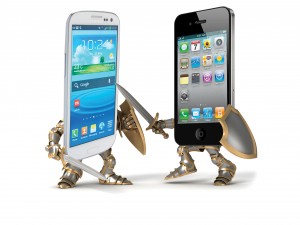While some, like Rita McGrath, argue that competitive advantage no longer exists in a technologically advanced, fast moving business world of today (McGrath, 2013), I disagree. To stay competitive in today’s market, companies must be extremely efficient while continuously being innovative with strategies. It is more efficient for a company to outsource work than to try and be completely self-sustainable. A company very familiar with outsourcing is Apple. Part of Apple’s strategy is in fact to outsource all of their manufacturing of product parts, and assembly, so they can focus on their strength: design (P.K, 2013). Apple’s outsourcing strategy has been effective thus far, allowing them to create a strong brand name, creating innovative touch-screen phones for a reliable customer base. That is until recently.
Customer loyalty has recently started to be questioned as Apple’s innovation seems to be slowing down, and their models seem to be copying that of Samsung’s Galaxy phone (Samsung Mobile USA, 2014). Samsung,their biggest competitor, also happens to be their largest supplier of parts (P.K, 2013), which is seemingly counterintuitive. Why would Apple help their rival make profit? As part of their business model, Apple has many key partners. Without these relationships they would not prosper. The fact is, business is not a zero-sum-game. Even though Apple is helping their competitor create revenue, they are helping themselves the most.
Works Cited:
McGrath, R. (2013). Transient advantage. Harvard Business Review, 91(6), 62–70.
P.K,. (2014). Slicing an Apple. The Economist. Retrieved 28 September 2014, from http://www.economist.com/blogs/dailychart/2011/08/apple-and-samsungs-symbiotic-relationship
Samsung Mobile USA,. (2014). Galaxy Note 4– Then and Now. Retrieved from https://www.youtube.com/watch?v=oxhSnNZH3Rk#t=25
